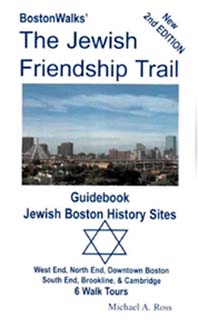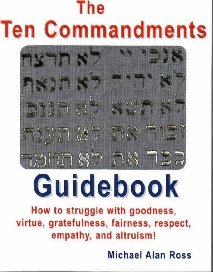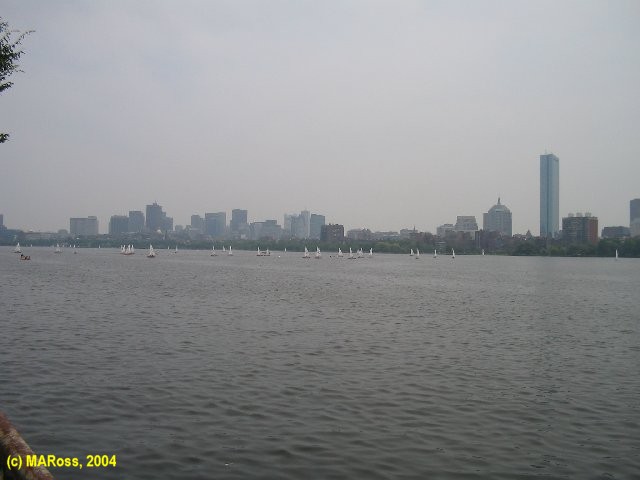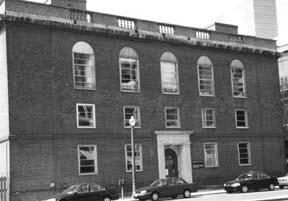"West End House" circa 2004 - Begun by 35 Jewish boys in
1903!Click here to connect with more of Boston's
Best! |
Now available!

The Jewish Friendship Trail Guidebook
6
Self-Guided Walking/Bicycling Jewish Boston History Tours
Covers
Boston, Brookline, and Cambridge
Softcover 198 pages with maps &
b/w photos
Print out this
Book Order Form
to order now!
|
Now available!

The Ten Commandments Guidebook
Ways to Self-Struggle with
Classic Morals
In Song, Poetry, and Prose
Covers 10 Commandments Plus One Other!
Softcover 153 pages with
practical suggestions pages!
Print out this
Book
Order Form
to order now!
|

BostonWalks'
"The Jewish Friendship
Trail"
A Walking Tour Trail to Sites of
Jewish
Experience
In Boston's
South End
Circa 1850s to 1920s

Email:
BostonWalks' "The Jewish Friendship Trail"

Hi,
We've been escorting walking tours of Boston for about twelve
years. Locating sites of Jewish experience here has been our favorite
challenge because few Jewish sites have plaques and, prior to our
creating The Jewish Friendship Trail, no Jewish-Boston path of history
had been delineated for walking and bicycling purposes. Boston's South
End, like most of Boston's West End, has had parts of it demolished as
a result of urban renewal. But, also like the West End, there are some
vivid reminders of Jewish-Bostonians passage through the South End's
streets. Here is a taste of BostonWalks' The Jewish Friendship Trail
in Boston's South End!
|
The Jews' arrival in mid-nineteenth century Boston was announced
in the early 1850s when a minyan (prayer-group) constructed Temple
Ohabei Shalom on Warren (now Warrenton) Street. For the next seventy-five
years, the Jews would maintain a presence in first the lower and then
the upper South End. During the first fifty of those seventy-five
years, the South End's small Jewish community, principally, consisted of
approximately 3,000 Central European "Reform" Jewish-Americans, many of
whom had early financial success in commerce. By the 1900s, that
small group was joined in the South End by larger numbers of Eastern
European "Traditional" Jewish-Americans, many of whom had yet to climb
the ladder of financial success. While most of the extant Jewish sites
in the South End reflect upon that earlier group's passage, several
of the later group's members have left memoirs about their lives
in the South End. This BostonWalks' "The Jewish Friendship Trail"
in Boston's South End is designed as a 1.5 hour walking tour.
It's best taken as part of an escorted group tour.
Let's walk, then, to these sites of Jewish Experience in
Boston's South End circa 1850s to 1920s:


Click on our Filene photo-collage to connect to Filene related sites!
- (2) Our second site is located across from and includes the Charles Street
Playhouse. Across the street from the once majestic playhouse building once
stood Boston's very first synagogue building. It consisted of a thirty by
forty-six feet structure which could seat about one hundred, twenty-five
families. Since, at its inception, the congregation followed traditional
worship patterns, the small facility had separate seating for men and women,
had a mikvah (bathhouse), and a Hebrew school. When the congregation
outgrew that small building, Ohabei Shalom purchased the building which
today houses the Charles Street Playhouse. This Playhouse building,
originally built in 1839 as a Universalist Church, then served Ohabei
Shalom from 1863 to 1886. During these years, Ohabei Shalom began the
transition from its orthodoxy to reform Judaism. Also, in this
building, Boston's Young Mens' Hebrew Association (YMHA) was founded.
After 1886, Ohabei Shalom moved to another South End facility which
we'll soon visit.
- (3) We'll now walk down Melrose Street from the corner of Broadway
where once stood Boston's second synagogue building, Adath Israel,
formed as a breakaway congregation from Ohabei Shalom within a short
period of time. For thirty years, Adath Israel congregated here.
Its well known reform leader, Rabbi Solomon Schindler, was hired here in
1874. Wandering down Melrose Street to Church Street, one almost
steps back in time among the many buildings dating back a century or
more. There once was at least one other synagogue here on Church Street
(at the corner of Winchester Street): Zions Holy Prophets of Israel
Memorial Synagogue (1878-1895). Other nearby shuls (houses of worship)
included Beth Eil and Anshe Poland.
- (4) Just a few blocks further Westward, near the corner of Berkeley
and Appleton Streets, we can glimpse a vivid reason why Jews felt
comfortable occupying several communal buildings at this intersection.
Here, in the first floor of the Theodore Parker meeting house,
Adath Israel ran its Sunday school beginning in 1875. Nearby,
Congregation Shaaray Tefilla occupied Paine Hall off and on
during the late 1870s and early 1880s. Shaaray Tefilla later
joined with Boston's third synagogue Mishkan Israel which had been
founded in 1858 to form Mishkan Tefilla.
- (5) Proceeding down Tremont Street to Union park Street, we'll
turn left and walk toward the corner of Washington Street. Here
stands another majestic building which once served as a synagogue: this
one was the third location for Ohabei Shalom. Originally the Unitarian
Church of well-known Bostonian, Edward Everett Hale; Ohabei Shalom
occupied this building from 1887 until the mid-1920s. Today, it is
a Greek Orthodox Church.
- (6)As host, about now we provide some oral-history about
the Emerald Street Synagogue and of the Harrison
Avenue shopping area. For example, Harrison Avenue was compared to Arlington Street in Chelsea by Mary
Antin when she wrote about her growing up in this neighborhood in
the first decade of the twentieth century. Filled with Jewish
grocers, butchers, bakers, tailors and so on; it, like Arlington
Street, was filled with vibrant, very small commerce.
- (7) Heading North, we'll cross Shawmut Avenue, on which, almost
a mile further West, the newly merged Mishkan Tefila, congregated
in a former church from 1897 to 1907.
- (8) Our next site gives us a good sense of the housing stock which
the Jews of the late nineteenth century occupied as they continued their
economic climb into the upper South End. We're walking up West Canton
Street now. By the 1870s, quite a few Jewish families owned and occupied
homes here. We'll stop particularly at one house which was home to Rabbi
Raphael Lasker. Rabbi Lasker served as Temple Ohabei Shalom's rabbi from
1876 to 1895. As Ohabei Shalom transitioned from it's second location (now
the Charles Street Playhouse) to its third location on Union Park Street,
Rabbi Lasker was a voice of Jewish moderation, maintaining a balance
for his synagogue's practices midway between traditionalism and Reform.
- (9) We're heading toward the most magnificent synagogue ediface
on this walking tour: Temple Israel (fka Adath israel). The
congregation's former building at the corner of Columbus Avenue
and Northampton Street has been the African Methodist-Episcopal Zion
Church for much longer than it was a synagogue but its facade reminds us
well of its original design (by Louis Weissbein), construction, and use.
At its dedication ceremony in 1884, Rabbi Lasker of Ohabei Shalom and Rev.
Edward Everett Hale and well as Temple Israel's own Rabbi Schindler gave
presentations. While the building only served Temple Israel for just over
two decades until 1906, its preservation is a wonder to behold.
- (10) Members from Temple Ohabei Shalom also formed one of Boston's
most successful social/business clubs,
the Elysium Club. While the Club's building no longer stands
on its site on Huntington Avenue, it was designed by the
same architect who designed the synagogue we just visited and
possibly emulated the grandeur of that building. For
quite a few years, the leadership of both Temple Israel and
the Elysium Club was under the strong guidance of Jacob
Hecht.
- (11) Our final site, appropriately, then, on the way back to the
starting point of this walking tour of Boston's
South End is one of the homes of one of Boston's most prominent Jewish
couples in the five decades between 1870 and 1920. While the site
is technically in the Back Bay, Jacob and Lina Hecht's
involvement in Boston Jewry transcended and crossed the boundaries among
the North, West and South Ends as well as between the Central and
Eastern European Jews of that era.
Now available!

The Jewish Friendship Trail Guidebook
6
Self-Guided Walking/Bicycling Jewish Boston History Tours
Covers
Boston, Brookline, and Cambridge
Softcover 198 pages with maps &
b/w photos
Print out this
Book Order Form
to order now!
|
Now available!

The Ten Commandments Guidebook
Ways to Self-Struggle with
Classic Morals
In Song, Poetry, and Prose
Covers 10 Commandments Plus One Other!
Softcover 153 pages with
practical suggestions pages!
Print out this
Book
Order Form
to order now!
|


Yea, Team! The Boston Red Sox and The New England Patriots!

From the Charles River, a red, white, and blue political agenda
flows!

Email:
BostonWalks
Telephone:617-489-5020


(Moses words to Joshua in Deut. 31:7)
|
 |

|
 |

|
 |
 |
 |

 ...How many?
...How many?





![]() Filene
Filene![]() Best of Boston
Best of Boston![]() NYC UWS
NYC UWS![]() Brandeis
Brandeis ![]() Love Your Neighbor
Love Your Neighbor![]() Watertown, New Town, & Muddy River
Watertown, New Town, & Muddy River![]() Walk Near Water
Walk Near Water![]() Refute Hate
Refute Hate![]() Walk West/North Ends
Walk West/North Ends














































